ikfoundation.org
The IK Foundation
Promoting Natural & Cultural History
Since 1988


 Crowdfunding Campaign
Crowdfunding Campaignkeep knowledge open, connected, and growing on this textile history resource...
NATURAL DYEING
– John Gerard’s Herbal of 1597 (1633)
During my research on textile dyeing for the project “TEXTILIA LINNAEANA – Global 18th Century Textile Traditions & Trade”, I came across a most interesting volume. It was a rare Herbal including numerous plants possible to use for natural dyeing, and on a few occasions, the accompanying texts also describe the herbs’ qualities as plants for dyeing. This essay aims to briefly introduce, make comparisons and share some quotes and illustrations from this comprehensive 16th century folio book.
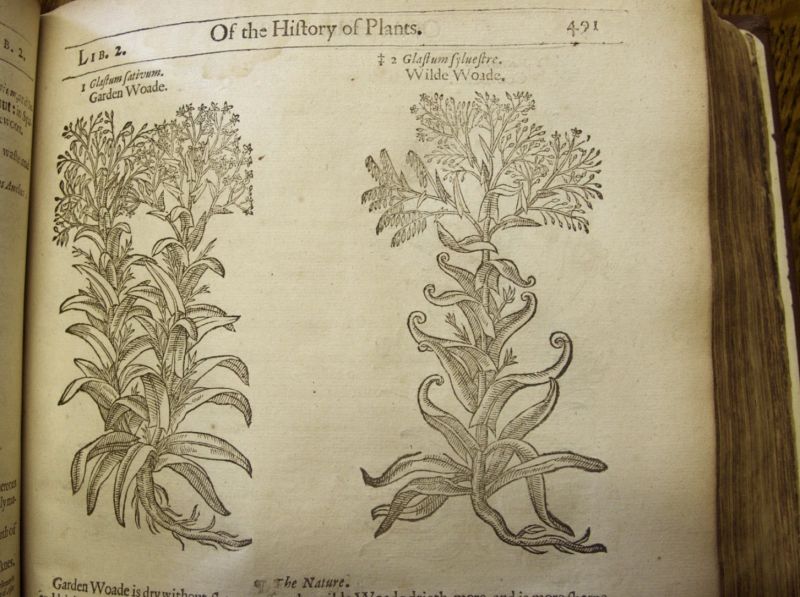 The dyeing properties for ‘Garden woade’ and ‘Wild woade‘ are described as: ‘It serueth well to dye and colour cloath, profitable to some few; and hurtfull to many.’ (pp. 490-91).
The dyeing properties for ‘Garden woade’ and ‘Wild woade‘ are described as: ‘It serueth well to dye and colour cloath, profitable to some few; and hurtfull to many.’ (pp. 490-91).John Gerard (1545-1611) was an English herbalist and botanist famous for his herbal garden, and his richly illustrated publication (Herbal or General Historie of Plantes) was widely known and used during the 17th century. Among numerous others, Gerard was also an important predecessor to Carl Linnaeus (1707-1778), the founder of the modern binomial nomenclature.
A Herbal of this kind was, first and foremost, a book describing the herbs’ medicinal and culinary properties, but some textile dyeing uses were also mentioned. The edition studied was printed in 1633, including a large number of woodcut illustrations of plant drawings and the said edition is also considered more accurate in many details than the original print. This is due to the fact that the botanist and apothecary Thomas Johnson (c. 1600-1644) made considerable revision work and extended the volume’s content.
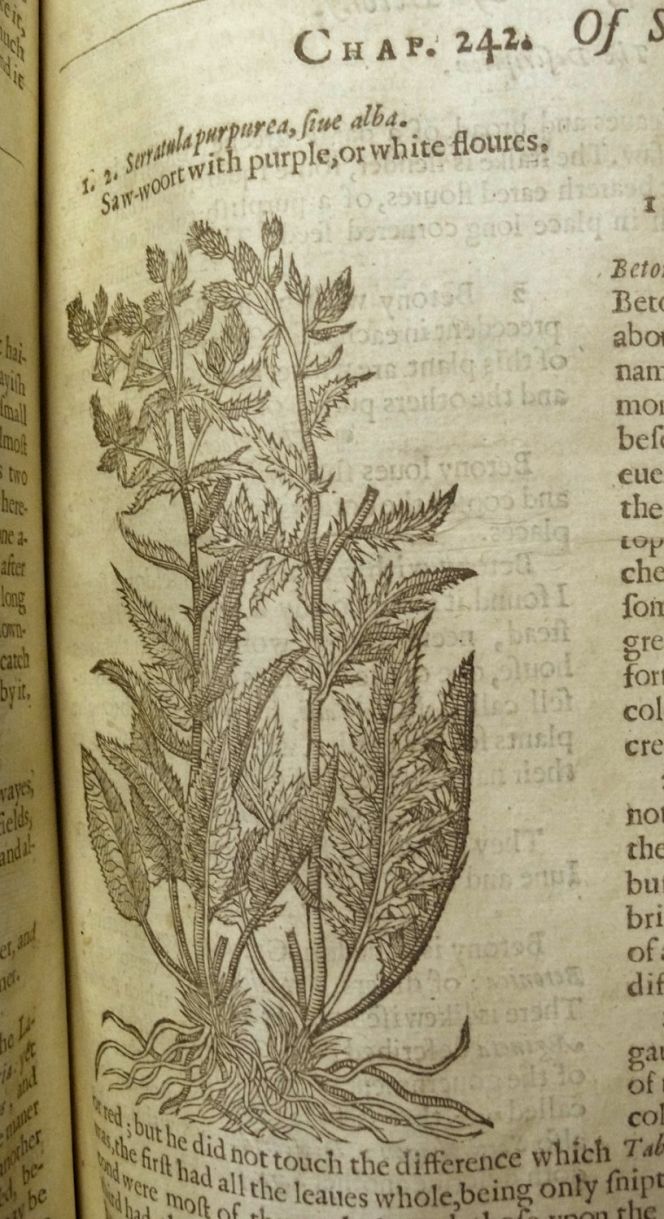 Saw-wort was common for dyeing yellow during many centuries and the text is hinting on its dyeing possibilities with the Latin name of the species “tinctoria”. Including: ‘The later age doe call them Serratula, and Serratula tinctoria…’ (p. 713).
Saw-wort was common for dyeing yellow during many centuries and the text is hinting on its dyeing possibilities with the Latin name of the species “tinctoria”. Including: ‘The later age doe call them Serratula, and Serratula tinctoria…’ (p. 713).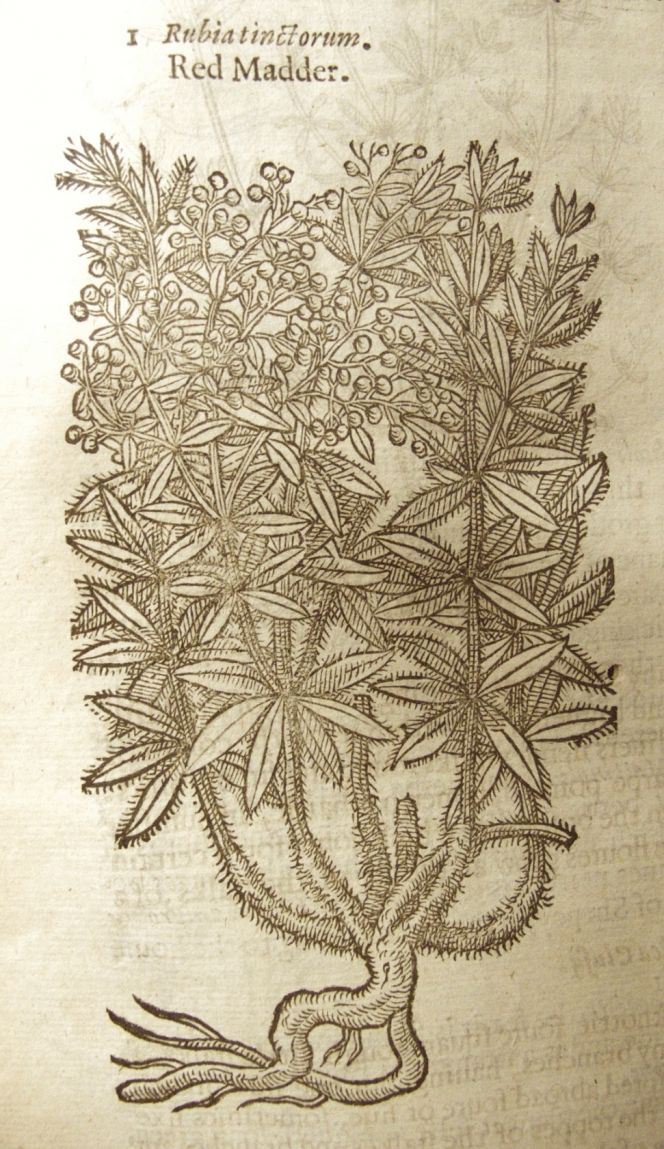 Red madder or Rubia tinctorum has an extensive text, but nothing is mentioned of its unsurpassable qualities for dyeing red shades on yarn and cloth. The plant is primarily described from a medicinal point of view (pp. 1118-21).
Red madder or Rubia tinctorum has an extensive text, but nothing is mentioned of its unsurpassable qualities for dyeing red shades on yarn and cloth. The plant is primarily described from a medicinal point of view (pp. 1118-21).However, the use of common madder (Rubia tinctorum) for durable reds was introduced many centuries prior to the publication of Gerard’s Herbal in Europe and continued to be popular. Carl Linnaeus, among other individuals, advocated for large-scale plantations during his journey through Skåne in the most southerly province of Sweden in 1749. Even if the cold northerly winters were unsuitable for the plant if not cultivated in very protected locations. For instance, on 13 June, he mentioned that common madder was grown at Malmö and ‘...grew abundantly at the master gardener Christian Müller’s without being covered in winter ... I could not but see that it here grew and flourished as prolifically as ever I had seen it in France or Flanders; for here was surely the opportunity to establish madder plantations in Skåne, as so much of the root is annually ordered from abroad and consumed by dyers’.
Some of the other illustrated plants suitable for natural dyes in Gerhard’s Herbal are woad for blue colours and northern bedstraw for red, while several herbs and trees give good and light-resistant shades for yellow/brown. The most important were saw-wort, white birch, common heather, safflower, lady’s bedstraw, common alder, tansy and wild marjoram.
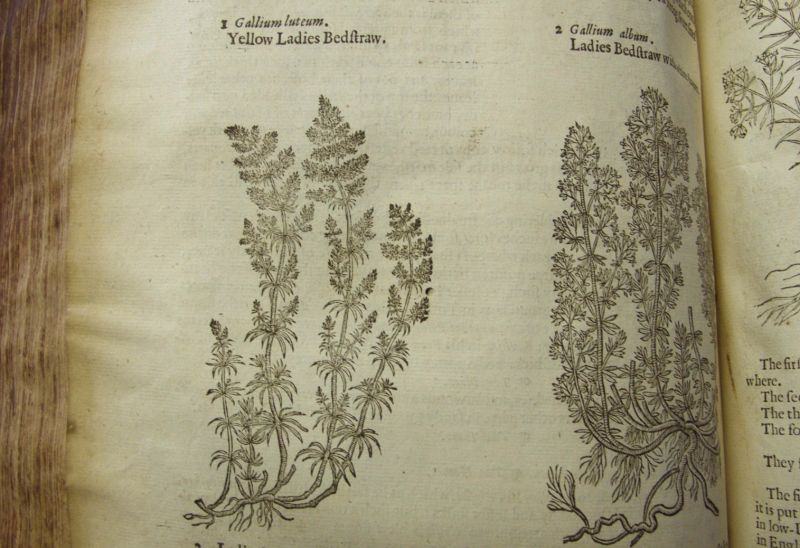 The accompanying text to ‘Yellow Ladies Bedstraw” and “Ladies Bedstraw with white flowers’ do however not mention those plants dyeing qualities for respectively yellow and red colours (pp. 1126-28)
The accompanying text to ‘Yellow Ladies Bedstraw” and “Ladies Bedstraw with white flowers’ do however not mention those plants dyeing qualities for respectively yellow and red colours (pp. 1126-28)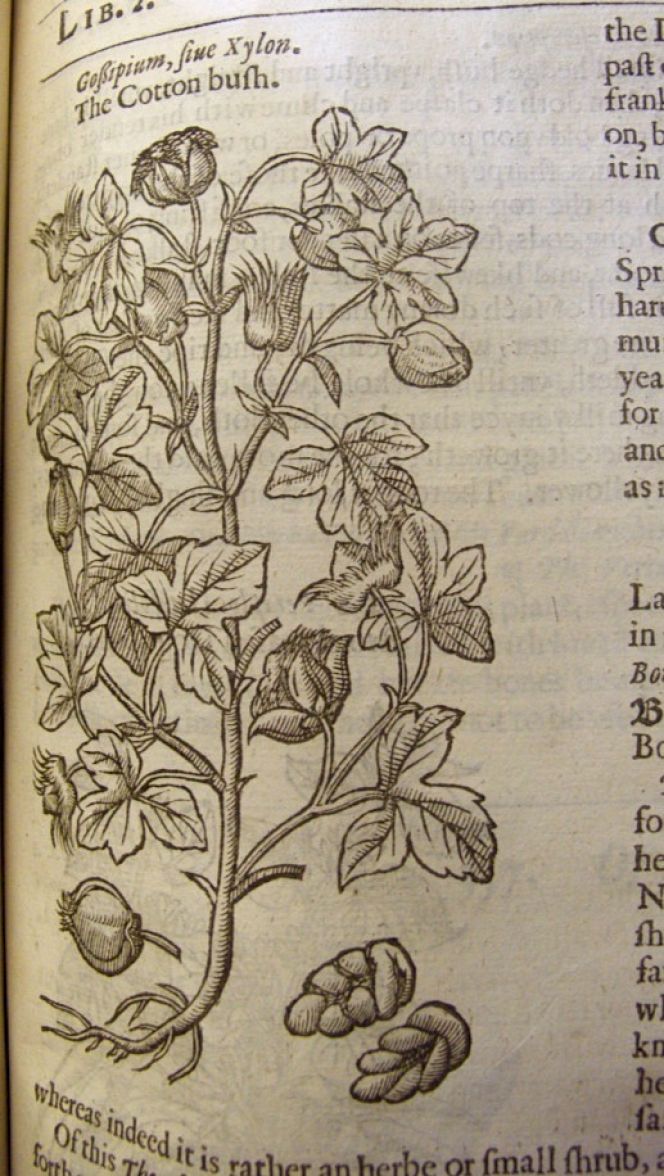 To conclude, a few notes on the subject of spinning materials. Here depicted with ‘The Cotton bush’ which among other matters is noted for its long history and the benefit for clothing as follows. ‘The upper part of Egypt toward Arabia bringeth forth a shrub which is called Gossipion, or Xylon, and therefore the linnen that is made of it is called Xylina. It is (faith he) the plant that beareth that wooll wherewith the garments are made which the Priests of Egypt do weare…’ (pp. 900-1)
To conclude, a few notes on the subject of spinning materials. Here depicted with ‘The Cotton bush’ which among other matters is noted for its long history and the benefit for clothing as follows. ‘The upper part of Egypt toward Arabia bringeth forth a shrub which is called Gossipion, or Xylon, and therefore the linnen that is made of it is called Xylina. It is (faith he) the plant that beareth that wooll wherewith the garments are made which the Priests of Egypt do weare…’ (pp. 900-1)The rare Herbal of ca 1,700 pages is kept at the Library and Archive, Whitby Literary & Philosophical Society, Whitby Museum, United Kingdom.
Sources:
- Gerard, John, Herbal or General Historie of Plantes, 1633 (first published 1597).
- Hansen, Viveka, Textilia Linnaeana – Global 18th-century Textile Traditions & Trade, London 2017.
- Linnaeus, Carl, Skånska Resa, på höga öfwerhetens befallning förrättad år 1749..., Stockholm 1751.
Essays
The iTEXTILIS is a division of The IK Workshop Society – a global and unique forum for all those interested in Natural & Cultural History.
Open Access Essays by Textile Historian Viveka Hansen
Textile historian Viveka Hansen offers a collection of open-access essays, published under Creative Commons licenses and freely available to all. These essays weave together her latest research, previously published monographs, and earlier projects dating back to the late 1980s. Some essays include rare archival material — originally published in other languages — now translated into English for the first time. These texts reveal little-known aspects of textile history, previously accessible mainly to audiences in Northern Europe. Hansen’s work spans a rich range of topics: the global textile trade, material culture, cloth manufacturing, fashion history, natural dyeing techniques, and the fascinating world of early travelling naturalists — notably the “Linnaean network” — all examined through a global historical lens.
Help secure the future of open access at iTEXTILIS essays! Your donation will keep knowledge open, connected, and growing on this textile history resource.
been copied to your clipboard




– a truly European organisation since 1988
Legal issues | Forget me | and much more...
You are welcome to use the information and knowledge from
The IK Workshop Society, as long as you follow a few simple rules.
LEARN MORE & I AGREE







